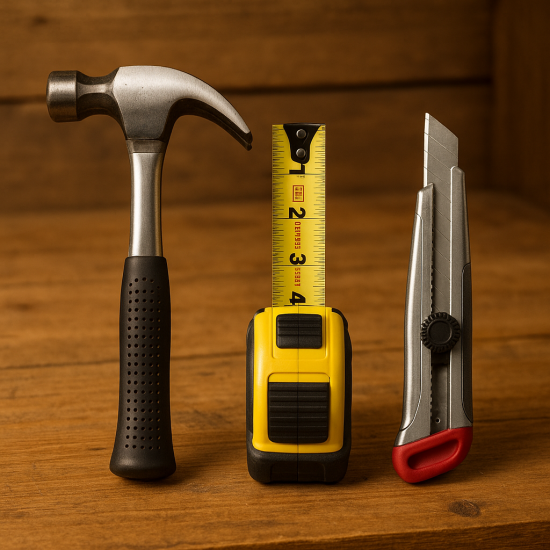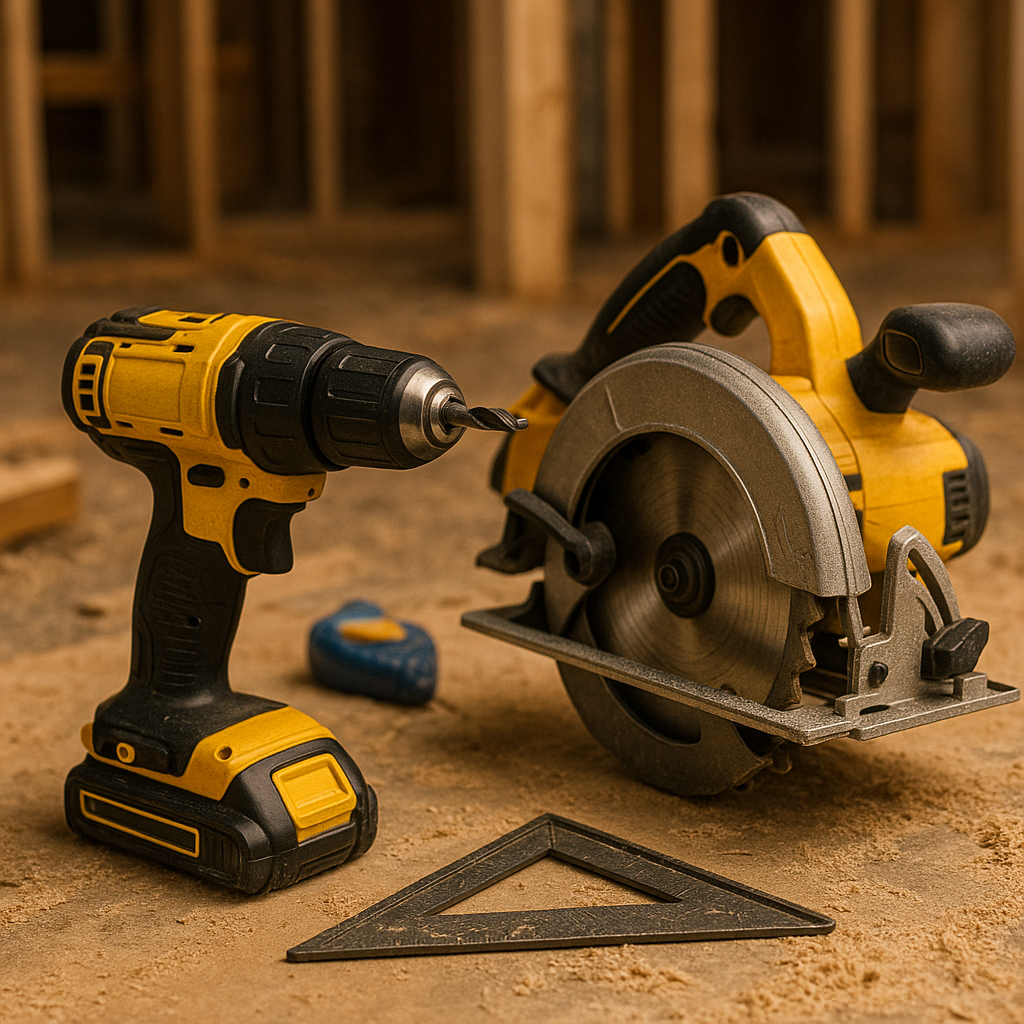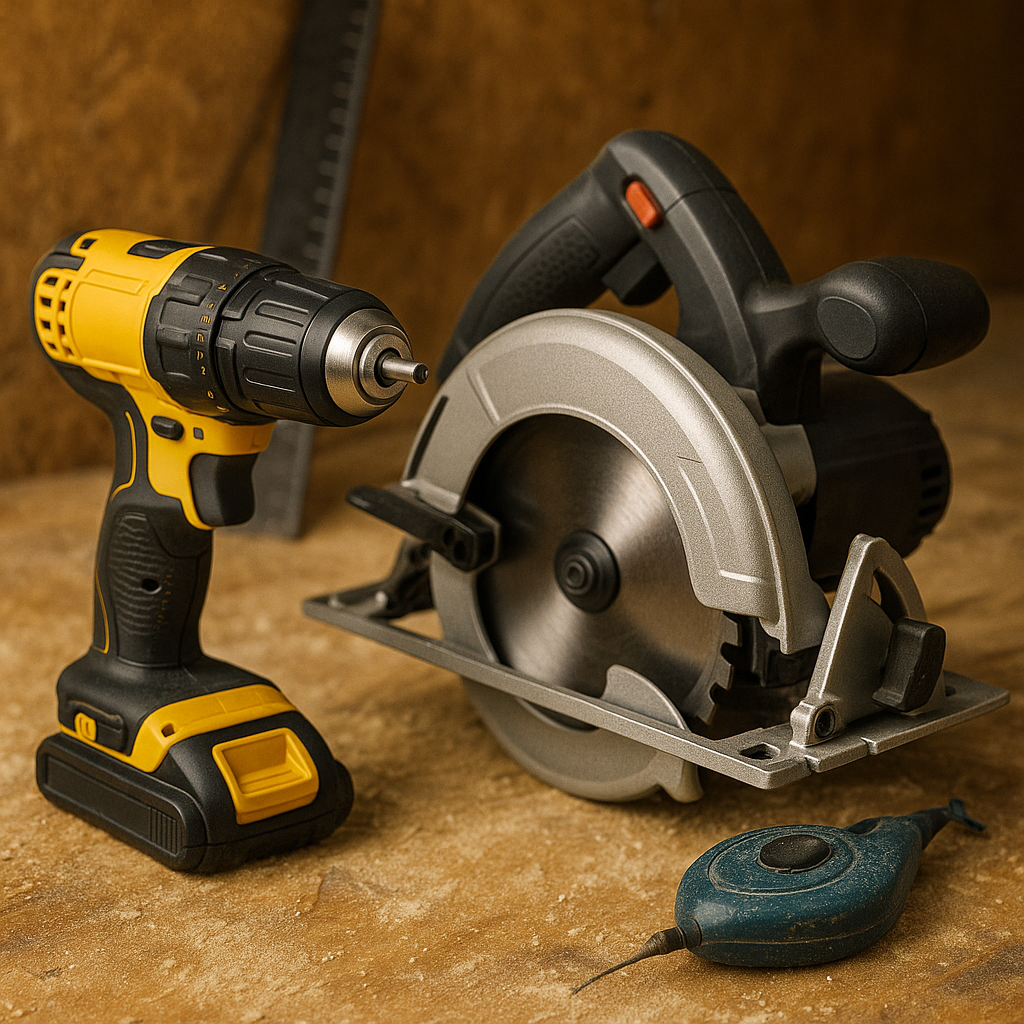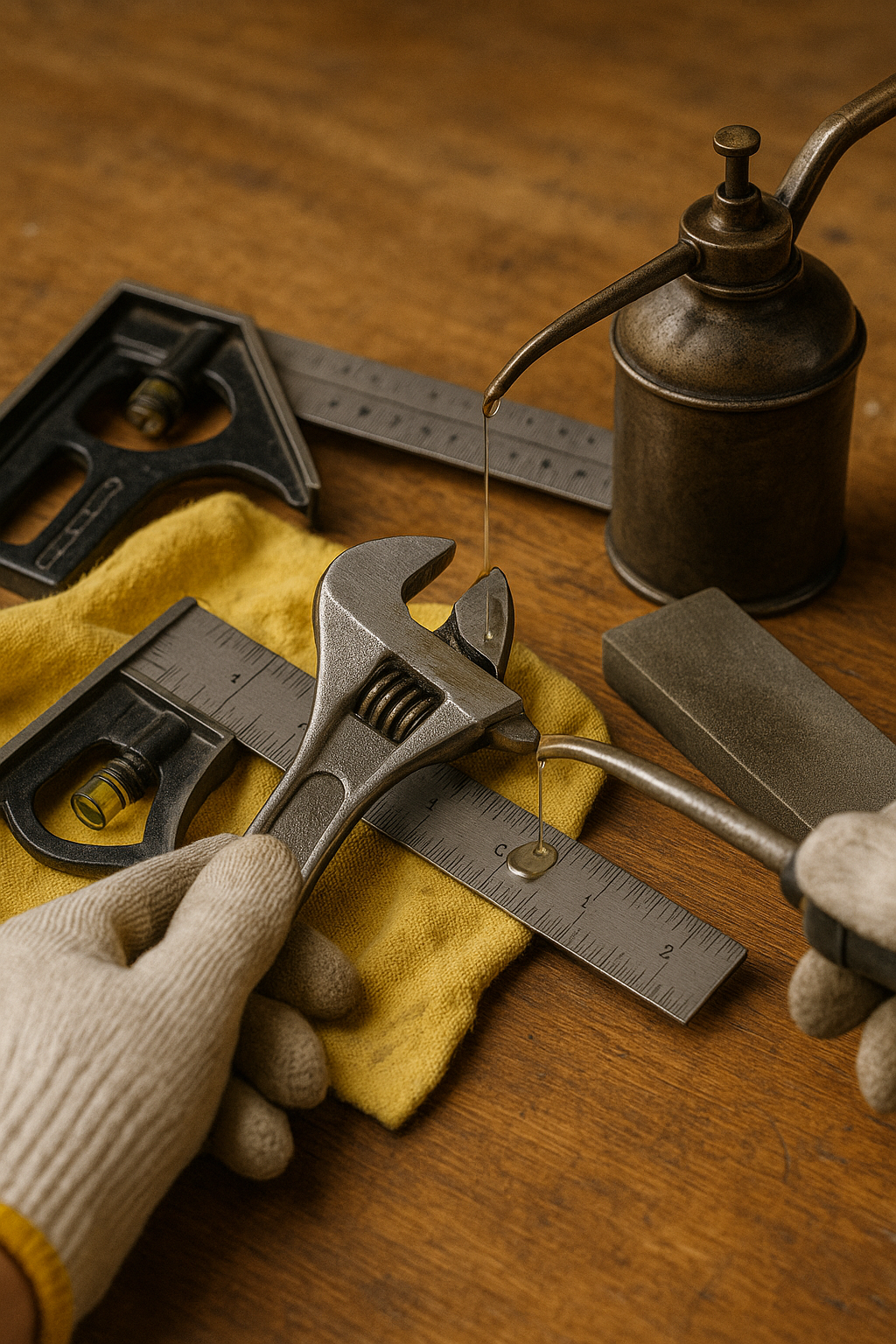10 Essential Construction Tools Every Pro Should Have – Reliable tools to build projects faster.

1. Claw Hammer
What it does:
A claw hammer is the quintessential tool for driving and removing nails. Its flat face hammers in nails, while the curved “claw” on the back extracts them.
Why it matters:
Whether framing a wall or hanging cabinets, you’ll use a hammer for countless tasks. Its reliable design makes it indispensable for rough carpentry and finishing work alike.
Maintenance tips:
- Inspect the handle for cracks and ensure the head is securely attached.
- Keep the striking face clean and free of dents to deliver consistent force.
- Store in a dry place to prevent rust on the head and corrosion on the handle’s metal parts.
2. Tape Measure
What it does:
Accurate measurements are the backbone of every construction project. A sturdy tape measure—typically 16 to 25 feet long—helps you layout studs, cut lumber, or verify space dimensions.
Why it matters:
Even a small measuring error can cause wasted materials or misaligned components. A reliable tape measure ensures precision on every job site.
Maintenance tips:
- Periodically clean the blade with a dry cloth to remove debris.
- Check the hook end to ensure it grabs edges correctly; a bent hook skews measurements.
- Retract slowly to avoid damaging the internal spring mechanism.

3. Utility Knife
What it does:
Also known as a box cutter, a retractable-blade utility knife cuts drywall, plastic sheeting, insulation, vinyl flooring, and more. Its replaceable blades make it versatile.
Why it matters:
From opening material packaging to trimming excess material on installations, a sharp utility knife speeds tasks and yields cleaner cuts than scissors or saws in tight spaces.
Maintenance tips:
- Replace the blade as soon as you notice dullness—tugging on dull blades risks slips.
- Wipe down the handle and sliding mechanism to clear sawdust or adhesive residue.
- Retract the blade fully before storing for safety and blade longevity.
4. Level
What it does:
Levels use a bubble vial (spirit level) or digital readout to confirm whether surfaces are perfectly horizontal (level) or vertical (plumb).
Why it matters:
Walls, cabinets, doors, and framing need to be straight. Even a slight tilt can cause problems down the line—doors that swing closed on their own, cabinets that appear crooked, or water pooling on surfaces.
Maintenance tips:
- Check calibration occasionally by placing the level on a known flat surface, flipping it end-to-end, and comparing bubble placement.
- Keep the vials clean and free of glue or paint splatters.
- Store horizontally or hang on a pegboard to prevent bending or warping.

5. Screwdriver Set
What it does:
A set of both flathead (slotted) and Phillips-head screwdrivers lets you drive or remove screws in everything from electrical boxes to cabinet hardware.
Why it matters:
While power tools can handle most screws, a good manual screwdriver set is essential for tight spots, precision work, and delicate fittings that require a lighter touch.
Maintenance tips:
- Match the screwdriver tip to the screw head to avoid stripping.
- Wipe bits clean of paint or debris so they seat fully.
- Ensure ergonomic handles are free from cracks; replace any that compromise grip comfort or safety.
6. Adjustable Wrench
What it does:
An adjustable wrench (often called a crescent wrench) has a jaw that slides to fit various nut and bolt sizes.
Why it matters:
On plumbing tasks, scaffold assembly, or securing hardware, you’ll often encounter fasteners of different sizes. One adjustable wrench can handle many of them, saving you from carrying multiple fixed wrenches.
Maintenance tips:
- Periodically lubricate the screw mechanism with light machine oil to ensure smooth jaw adjustment.
- Realign or tighten the jaw if it gets loose; a wobbling jaw leads to rounded fasteners.
- Wipe off mud or grease after use to prevent buildup that hinders adjustment.

7. Cordless Drill
What it does:
A cordless drill/driver powers drill bits and screwdriver bits using a rechargeable battery. It handles everything from drilling pilot holes in wood to driving screws into metal.
Why it matters:
Cordless drills are versatile workhorses. Without the constraints of a cord, you can maneuver around job sites easily. Modern lithium-ion batteries deliver consistent torque and long run times.
Maintenance tips:
- Fully charge batteries before storing and avoid leaving them discharged for long periods.
- Clean out the chuck with a small brush to remove dust and debris.
- Periodically run a few drops of oil into the chuck’s jaws to prevent rust and maintain smooth opening/closing.
8. Circular Saw
What it does:
A circular saw uses a toothed blade to make straight cuts through lumber, plywood, or even metal with the right blade installed.
Why it matters:
While miter saws excel at crosscuts and compound cuts, a circular saw is more portable. You can rip full sheets of plywood on the job site and make long, straight cuts in studs or decking boards.
Maintenance tips:
- Inspect the blade regularly: replace it if teeth are dull or chipped.
- Keep the base plate clean and free of debris to ensure accurate cuts.
- Lubricate the blade guard so it swings freely without sticking, which prevents accidental exposure.
9. Chalk Line
What it does:
A chalk line tool is essentially a cord coated in colored chalk powder. You stretch it across a layout, snap it taut, and it leaves a straight chalk mark on the surface.
Why it matters:
For laying out walls, floor tiles, decking, or roof sheathing, a straight guideline is essential. A chalk line is quick, precise, and easy to erase when you need to adjust.
Maintenance tips:
- Refill with high-quality chalk powder for bold, visible lines.
- Periodically loosen and retension the cord so it snaps crisply instead of sagging.
- Store the chalk line indoors to prevent moisture from clumping the chalk.
10. Combination Square
What it does:
A combination square has a ruler (blade) with a sliding head that can be locked at 90° or 45°, used for marking or checking angles, depth measurements, and as a makeshift straightedge.
Why it matters:
During fine carpentry tasks—like laying out dovetail joints, checking the squareness of framing, or marking tenon shoulders—a combination square delivers the precision you need.
Maintenance tips:
- Keep the blade free of rust. Wipe after each use and apply a thin film of rust inhibitor if needed.
- Ensure the head locks tightly; a wobbly head leads to inaccurate layouts.
- Check calibration occasionally by setting the head at 90° and verifying against a known square.
Final Tips for Proper Tool Care
- Clean After Every Use: Dust, dirt, and construction debris can accelerate wear. Wipe tools down before returning them to their toolbox.
- Sharpen and Replace Blades: Handsaws, utility knives, and other cutting tools require sharp edges to work safely and efficiently. Schedule routine sharpening or blade replacement.
- Lubricate Moving Parts: Hinges, chucks, sliding mechanisms, and trigger assemblies benefit from periodic light-oiling to prevent rust and ensure smooth operation.
- Store in a Dry, Organized Space: A well-organized toolbox or wall-mounted rack keeps tools accessible and protected. Avoid leaving tools on the ground where moisture can cause corrosion.
- Inspect Fasteners and Cords: Check electrical cords for frays, battery packs for swelling, and fasteners (like hammer heads or wrench jaws) for signs of damage. Replace or repair before they fail on the job.
By investing in these ten essential construction tools—and keeping them well-maintained—you’ll be equipped for virtually any building task, ensure your work stands up to professional standards, and safeguard your investment in quality gear.